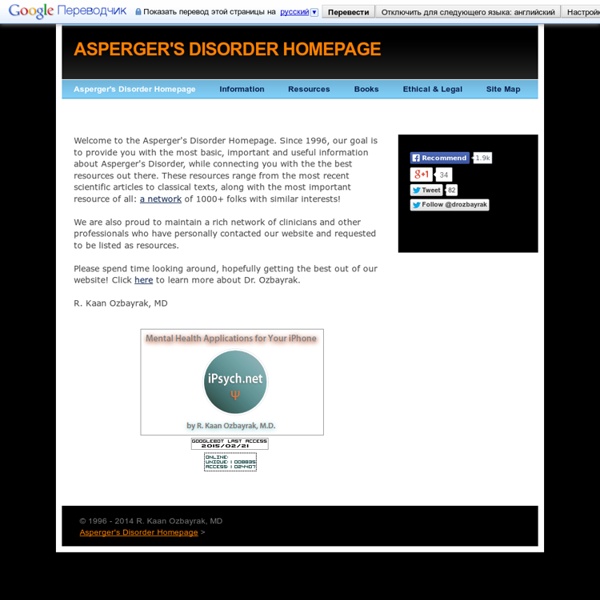



Asperger syndrome Asperger syndrome (AS), also known as Asperger disorder (AD) or simply Asperger's, is an autism spectrum disorder (ASD) that is characterized by significant difficulties in social interaction and nonverbal communication, alongside restricted and repetitive patterns of behavior and interests. It differs from other autism spectrum disorders by its relative preservation of linguistic and cognitive development. Although not required for diagnosis, physical clumsiness and atypical (peculiar, odd) use of language are frequently reported.[1][2] The syndrome is named after the Austrian pediatrician Hans Asperger who, in 1944, studied and described children in his practice who lacked nonverbal communication skills, demonstrated limited empathy with their peers, and were physically clumsy.[3] The modern conception of Asperger syndrome came into existence in 1981[4] and went through a period of popularization,[5][6] becoming standardized as a diagnosis in the early 1990s. Classification Causes
Teaching Students with Aspergers Syndrome: Tips for Teachers and Parents Students with asperger's syndrome may experience difficulties with focusing as well as lack of focus. Focus involves attention. Sometimes asperger's students focus all their attention on a particular object or subject; therefore, they fail to focus on what information the instructor is presenting. To overcome this problem, the teacher can try to establish some connection between the object or subject of interest and the area of study. The possibilities for instruction are endless, but it will take some time and creative planning on the part of the teacher. Sensory issues affect learning for the student with asperger's syndrome. Often aperger's students are distracted by something in the environment that they simply cannot control. This sensory overload the asperger student experiences may overwhelm them, so focusing can be difficult and frustration occurs. Obviously, a teacher does not want disruptions in the classroom.
Asperger Syndrome Fact Sheet Asperger syndrome (AS) is an autism spectrum disorder (ASD), one of a distinct group of complex neurodevelopment disorders characterized by social impairment, communication difficulties, and restrictive, repetitive, and stereotyped patterns of behavior. Other ASDs include autistic disorder, childhood disintegrative disorder, and pervasive developmental disorder not otherwise specified (usually referred to as PDD-NOS). ASDs are considered neurodevelopmental disorders and are present from infancy or early childhood. Although early diagnosis using standardized screening by age 2 is the goal, many with ASD are not detected until later because of limited social demands and support from parents and caregivers in early life. The severity of communication and behavioral deficits, and the degree of disability, is variable in those affected by ASD. Two core features of autism are: a) social and communication deficits and b) fixated interests and repetitive behaviors.
iPad Apps for Autistic Students Apps on portable devices such as the Apple iPad can help non-verbal children to communicate basic needs. Intuitive apps that employ colorful images and sounds can also hold a child's attention long enough to learn and offer effective tools to build vocabulary and reinforce word knowledge. The following iPad apps are designed to augment self-expression among children with autism spectrum disorders and other cognitive impairments. Becoming more comfortable with language may also encourage more safe social interaction among family members and classmates. 1. Apple iTunes Store Autism Xpress is a free app that encourages people with autism to recognize and express emotions. 2. Grace is a picture exchange system designed to encourage independent social interaction among people with autism. 3. iConverse iConverse is designed for children with autistic and other communicative disabilities who have not yet mastered basic speech. 4. 5.
Asperger's Syndrome Symptoms in Children, Teens, Adults Although there are many possible symptoms of Asperger's syndrome, the main symptom is significant trouble with social situations. Your child may have mild to severe symptoms or have a few or many of these symptoms. Because of the wide variety of symptoms, no two children with Asperger's are alike. Symptoms during childhood Parents often first notice the symptoms of Asperger's syndrome when their child starts preschool and begins to interact with other children. Not pick up on social cues and may lack inborn social skills, such as being able to read others' body language, start or maintain a conversation, and take turns talking.Dislike any changes in routines.Appear to lack empathy.Be unable to recognize subtle differences in speech tone, pitch, and accent that alter the meaning of others' speech. A child with one or two of these symptoms does not necessarily have Asperger's syndrome. Symptoms during adolescent and teen years Most symptoms persist through the teen years.